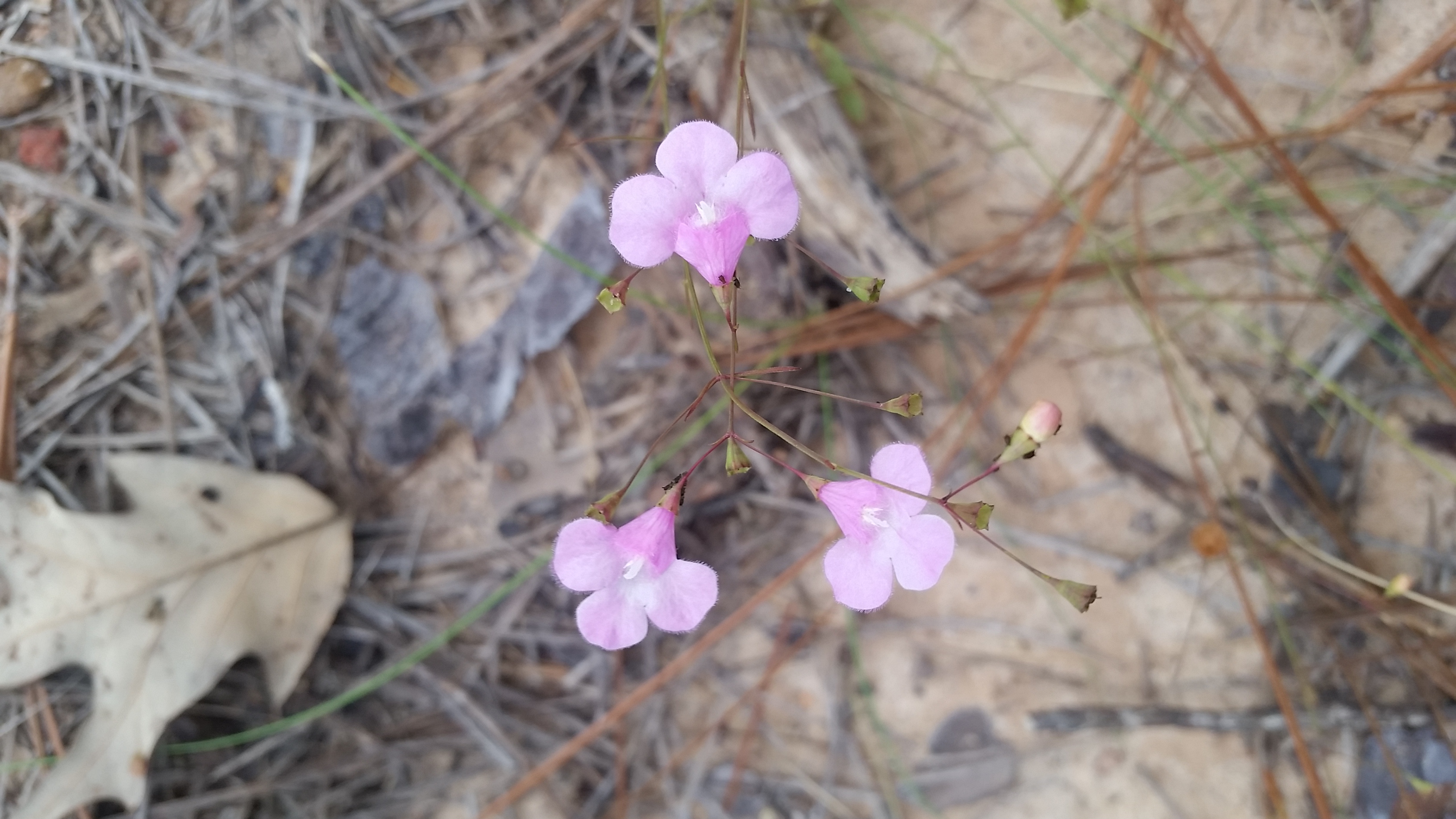Agalinis divaricata
| Agalinis divaricata | |
|---|---|

| |
| Photo by Michelle Smith at Torreya State Park | |
| Scientific classification | |
| Kingdom: | Plantae |
| Division: | Magnoliophyta - Flowering plants |
| Class: | Magnoliopsida - Dicotyledons |
| Order: | Lamiales |
| Family: | Orobancheaceae |
| Genus: | Agalinis |
| Species: | A. divaricata |
| Binomial name | |
| Agalinis divaricata (Chapm.) Pennell | |

| |
| Natural range of Agalinis divaricata from USDA NRCS Plants Database. | |
Common names: pineland false foxglove, little gerardia, pineland agalinis
Contents
Taxonomic notes
Synonym: Gerardia divaricata Chapm.[1]
Description
It is an annual and flowers in the summer and fall.[2][3]
Distribution
Agalinus divartica is infrequent in central, north, and west Florida, but is endemic to Mississippi, Alabama, and Florida[2]. It is listed as critically imperiled in Alabama and Georgia.[4]
On the Florida panhandle and northern peninsula, observations have been made from Santa Rosa county[5][6], eastward to Leon and Wakulla, and in Levy, Alachua, Marion, Citrus, and Hernando counties.[5]
Ecology
Habitat
A. divaricata occurs primarily in well drained and loamy sands such as pine-oak sandhill communities, sand dunes, interdune hollows (Entisols), and pine flatwoods communities (Spodosols). It thrives in frequently burned areas,[7] and in human disturbed areas such as pine plantations, old fields, along roadside edges and ditches where there are high levels of light.[7]
Agalinis divaricata is an indicator species for the Panhandle Silty Longleaf Woodlands community type as described in Carr et al. (2010).[8]
Associated species include Morella cerifera, Agalinis pulchella, Agalinis aphylla, Agalinis tenuifolia, Agalinis plukenetii, Quercus laevis, Aristida stricta, Liatris gracilis, and others.[7]
Phenology
Agalinis divaricata has been observed to flower between September to December with the peak of inflorescence in October.[9][5]
Fire ecology
It thrives in frequently burned areas.[7]
Herbivory and toxicology
Like other Agalinis species, A. divaricata hosts larvae of the common buckeye butterfly (Junonia coenia) in Florida.[5]
Conservation, cultivation, and restoration
A. divaricata requires fire or other vegetation-removing disturbance to maintain high light levels in the habitat which also reduces competition. It does not appear to be common in areas with a great deal of soil disturbance, although it occurs along roadsides and ditches.[7] This species is highly threatened by land-use conversion, habitat fragmentation and forest management practices.[4]
Cultural use
Photo gallery
References and notes
- ↑ Weakley, A.S. 2020. Flora of the Southeastern United States. Edition of 20 October 2020. University of North Carolina at Chapel Hill, Chapel Hill, North Carolina.
- ↑ 2.0 2.1 Hall, David W. Illustrated Plants of Florida and the Coastal Plain: based on the collections of Leland and Lucy Baltzell. 1993. A Maupin House Book. Gainesville. 341. Print.
- ↑ Wunderlin, Richard P. and Bruce F. Hansen. Guide to the Vascular Plants of Florida. Second edition. 2003. University Press of Florida: Gainesville/Tallahassee/Tampa/Boca Raton/Pensacola/Orlando/Miami/Jacksonville/Ft. Myers. 546. Print.
- ↑ 4.0 4.1 [[1]]NatureServe. Accessed: March 21, 2016
- ↑ 5.0 5.1 5.2 5.3 Observation by Roger Hammer in Silver Springs State Park, Marion County, FL. September 2016, posted to Florida Flora and Ecosystematics Facebook Group August 4, 2017.
- ↑ Observation by Kim Davis in Blackwater Forest and Garcon Point Nature Trail, Santa Rosa County, FL, September 19-28, 2003, posted to Florida Flora and Ecosystematics Facebook Group September 20126.
- ↑ 7.0 7.1 7.2 7.3 7.4 .Florida State University Robert K. Godfrey Herbarium database. URL: http://herbarium.bio.fsu.edu. Last accessed: June 2014. Collectors: Sidney McDaniel, Andre F. Clewell, Robert K. Godfrey, Paul O. Schallert, J. M. Canne, John Morrill, Loran C. Anderson, J. Hays, Robert Kral, Jean W. Wooten, H. E. Grelen, John C. Semple, L. Brouillet, Wilson Baker, H. Roth, V Craig, Bill Boothe, Marcia Boothe, R. A. Norris, and T. MacClendon. States and Counties: Florida: Bay, Calhoun, Franklin, Gadsden, Gulf, Jackson, Leon, Liberty, Levy, Okaloosa, Santa Rosa, Wakulla, Walton, and Washington.
- ↑ Carr, S.C., K.M. Robertson, and R.K. Peet. 2010. A vegetation classification of fire-dependent pinelands of Florida. Castanea 75:153-189.
- ↑ Nelson, G. PanFlora: Plant data for the eastern United States with emphasis on the Southeastern Coastal Plains, Florida, and the Florida Panhandle. www.gilnelson.com/PanFlora/ Accessed: 6 DEC 2016